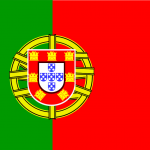How to Increase Online Store Conversions by Using Product Recommendations: Quelle Case Study
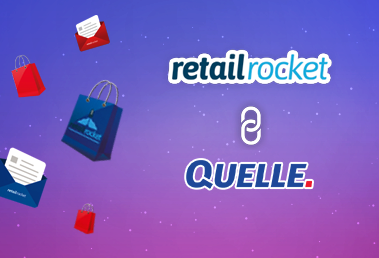
Fashion retail is one of the most diverse e-commerce industries in terms of the range offered and a very high proportion of emotional purchases. This means that sometimes a visitor to the website is simply unable to browse the entire range and locate suitable products. However, timely product recommendations would help to point the customer in the right direction, thus increasing online store conversions. The more items the customers see that are of interest to them, the more likely they are to make a purchase, which is why it is very important to thoroughly research the introduction of personalized recommendations at different stages of the customer’s journey — from the homepage to the shopping cart page, remembering to take into account special features of each page.
We will take Quelle online store as an example today to discuss how product recommendations help to increase conversions on 3 of the pages of the website:
- Homepage
- Category page
- Shopping cart page
All research on effectiveness was conducted using A/B testing on the desktop version of the website.
Scenario 1. Testing the Effectiveness of Product Recommendations on the Homepage
The optimization of the recommendation system for the Quelle.ru online store was started with an effectiveness study of various recommendation algorithms on the website’s homepage.
All website visitors were randomly divided into three segments:
1. The first segment was shown the store’s best sellers
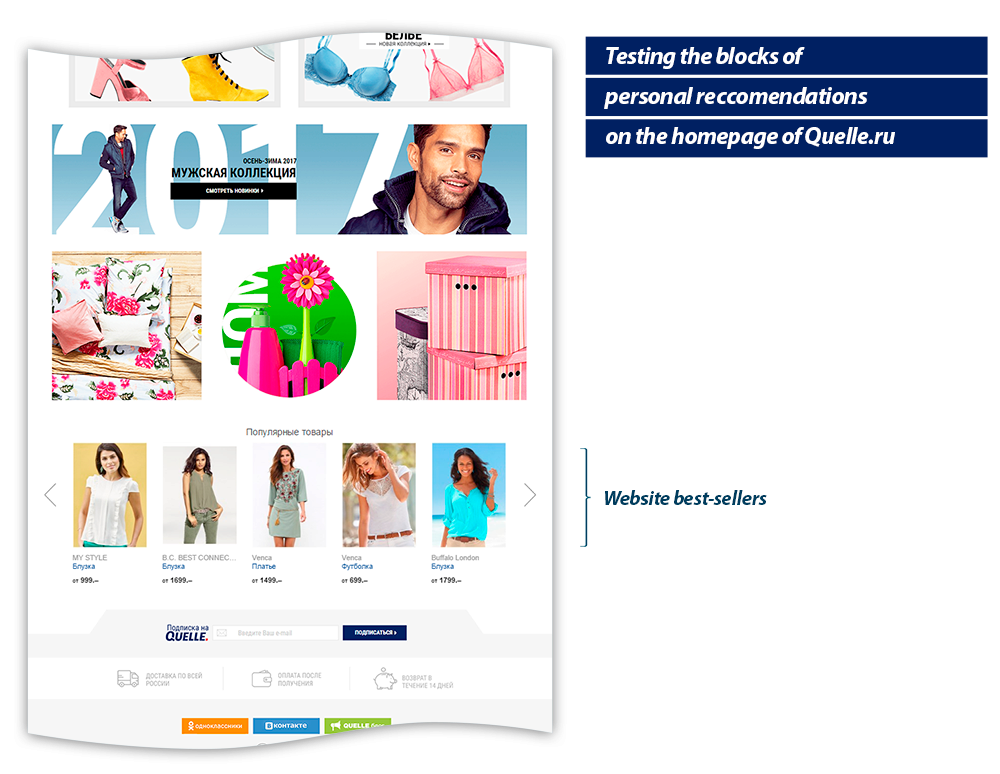
2. The second segment was shown personalized best sellers, taking into account the customers’ interests
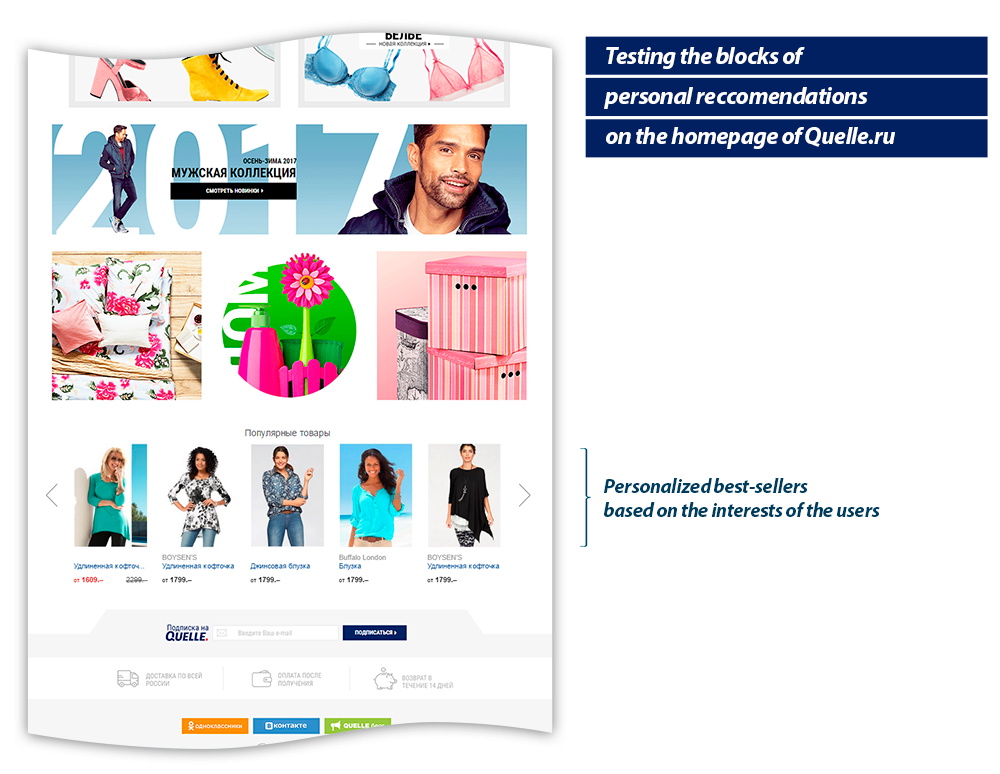
3. The third segment was a control group, with no recommendations displayed
Results
The test showed the following results:
| Conversion increase | |
| Best sellers | +0.65% |
| Personalized best sellers | +3.3% |
| Control group | – |
Conclusion
According to the test results, the use of the “Personalized best sellers” mechanics on the homepage of Quelle.ru online store increases the conversion rate for visitors on the page with a recommendation block by 3.3% with a statistical significance of 98.7%.
Scenario 2. Testing the Effectiveness of Product Recommendations on the Homepage
Based on the results of the previous test, we found that the highest conversion rate was for the “Personalized best sellers” block, and we decided to find out at the next stage what impact the increase in the number and arrangement of recommendation blocks on the homepage will have on the conversion rate.
The effectiveness study was conducted using the mechanics of A/B testing.
All website visitors were randomly divided into three segments:
1. The first segment was shown a block with personalized best sellers
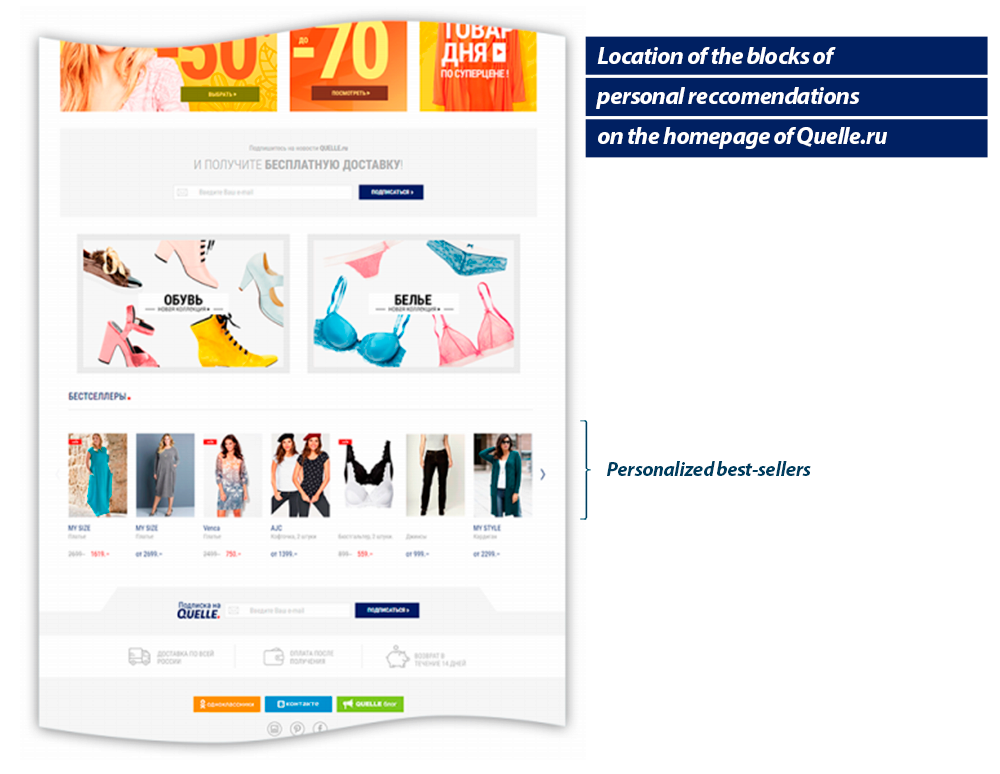
2. The second segment was shown personalized best sellers (at the top) and personalized recommendations based on the past interactions with the items (under the first block)
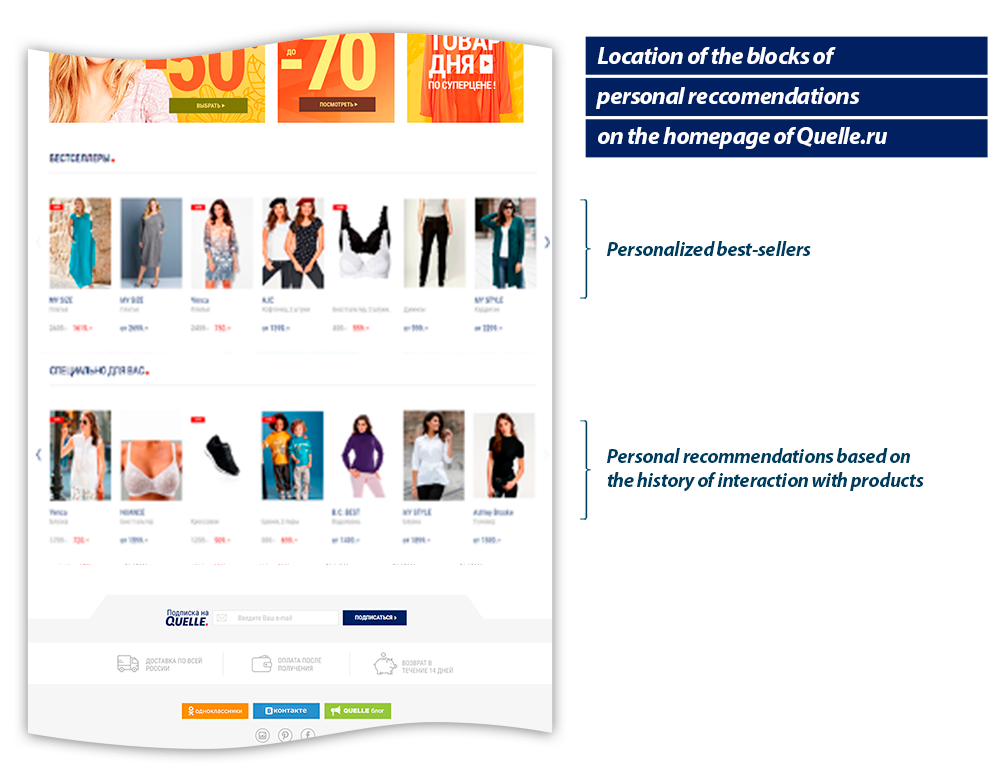
3. The third segment was shown the reverse order of the previous scenario, i.e. personalized recommendations based on past interactions with the items (at the top) and personalized best sellers (under the first block).
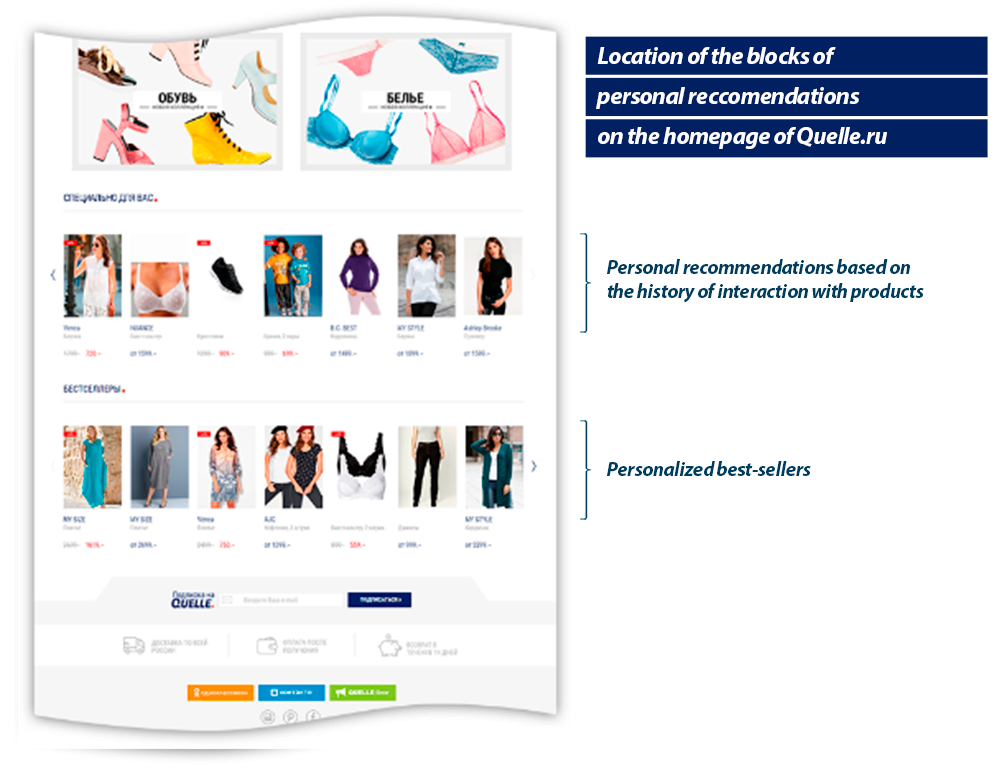
Results
The test showed the following results:
| Conversion increase | |
| Personalized best sellers (control group) | — |
| Personalized best sellers (top) + Personalized recommendations based on browsing history (bottom) | -1.8% |
| Personalized recommendations based on browsing history (top) + Personalized best sellers (bottom) | -2.6% |
Conclusion
Based on the results of testing this hypothesis, we found that adding a second block of recommendations on the homepage of the Quelle.ru online store is not an effective change, and this hypothesis should be rejected.
Application of the mechanics of “Personalized best sellers” without additional recommendation blocks on the homepage of Quelle.ru online store is the most effective configuration.
The findings again prove that the same mechanics can produce different results on different websites, and any significant changes should only be applied after detailed research of their impact on key performance indicators of the online store, rather than mindlessly following the latest trends.
Scenario 3. Testing the Effectiveness of Product Recommendations on the Category Page
If customers come to the category page, they are already showing an interest in this group of products, so it is worth showing the users the models that are of the most interest to them in order to help customers navigate the wide selection.
Continuing our work on optimizing the recommendation system on the Quelle.ru online store, we conducted research on the effectiveness of various recommendation algorithms on the store’s category page.
With the help of the A/B testing mechanics, all visitors to the website were randomly divided into three segments:
The first segment was shown the best sellers in the category
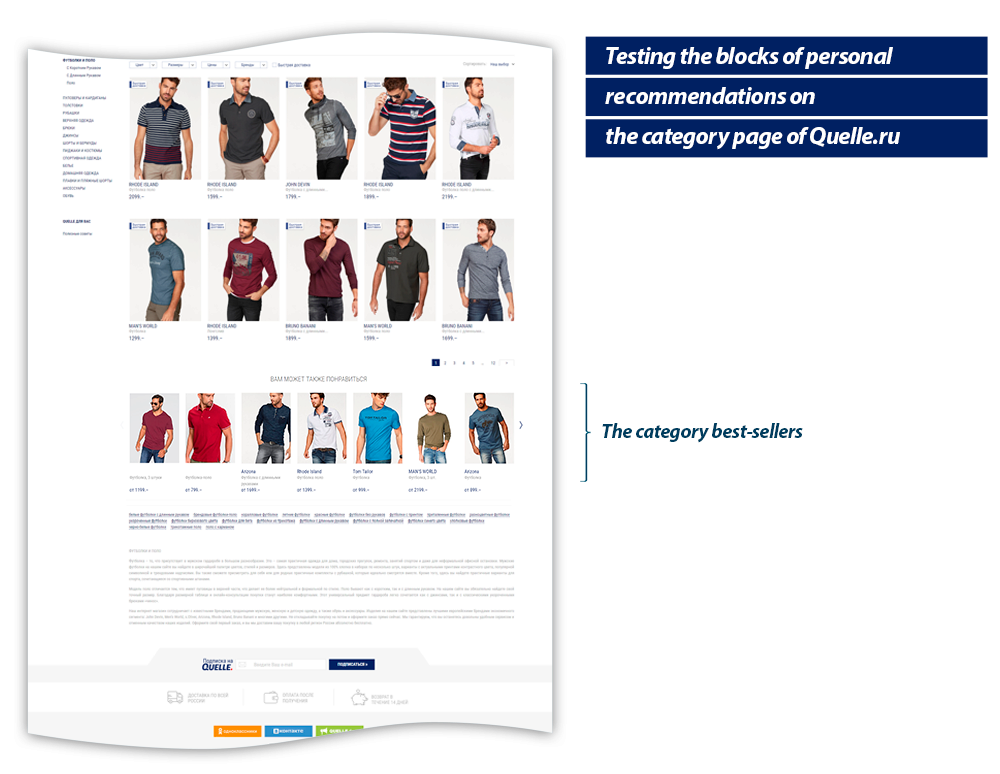
The second segment was shown the best sellers in the category that were personalized considering the user’s interests
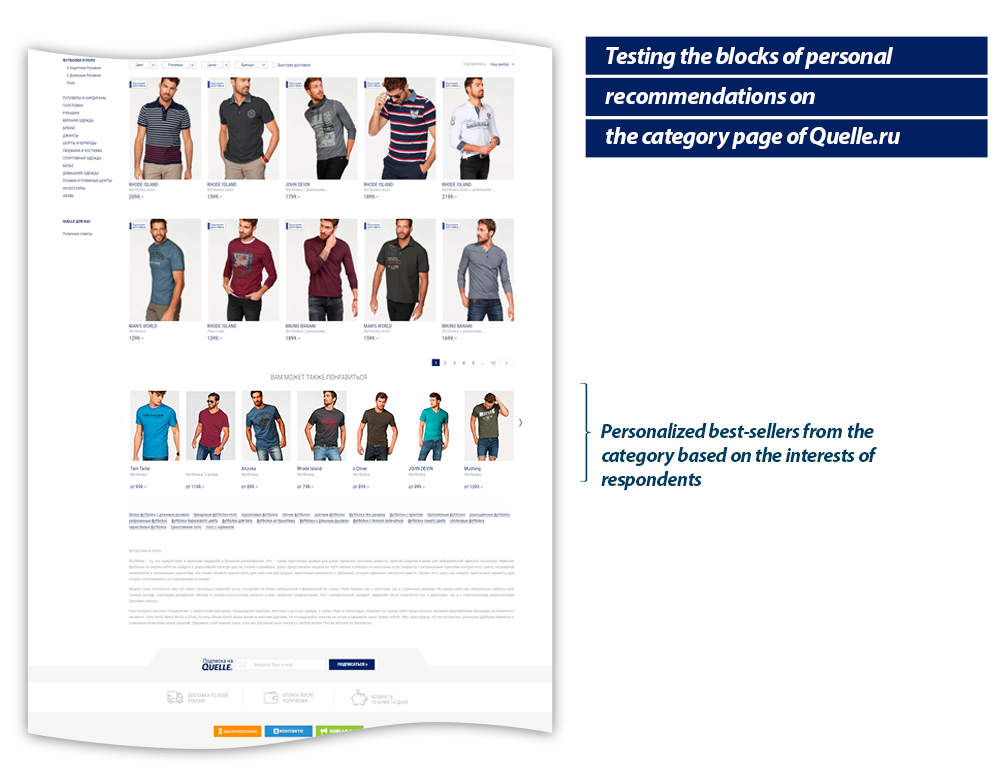
The third segment was a control group, with no recommendations displayed
Results
The test showed the following results:
| Conversion increase | |
| Best sellers in the category | +3.5% |
| Personalized best sellers in the category | +6.4% |
| Control group | — |
Conclusion
According to the test results, the use of the “Personalized best sellers in the category” mechanics on the category page of Quelle.ru online store increases the conversion rate of the visitors to the page with a recommendation block by 6.4% with a statistical significance of 99.96%.
Scenario 4. Testing the Effectiveness of Product Recommendations on the Shopping Cart Page
The shopping cart page is a great opportunity to offer related items to the user that could complement the customer’s choice. This will help to increase the number of items at the checkout.
A study on the effectiveness of various recommendation algorithms on the cart page of Quelle.ru online store was conducted in order to identify the most effective configuration for recommendations on the store’s cart page. The effectiveness study was conducted using the mechanics of A/B testing.
All website visitors were randomly divided into five segments:
The first segment was shown related items, i.e. those complementing the models added to the cart.
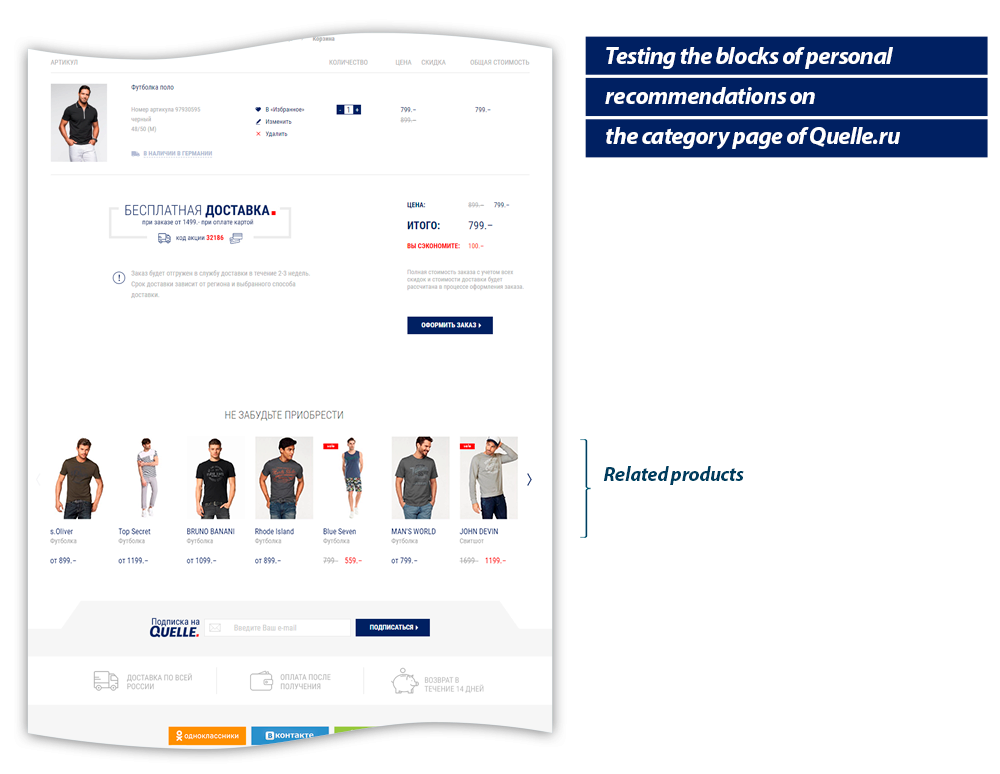
The second segment was shown related items, except for the items in the categories that were added to the cart. This allows making the selection more diverse, increasing the likelihood of adding related items to the cart.
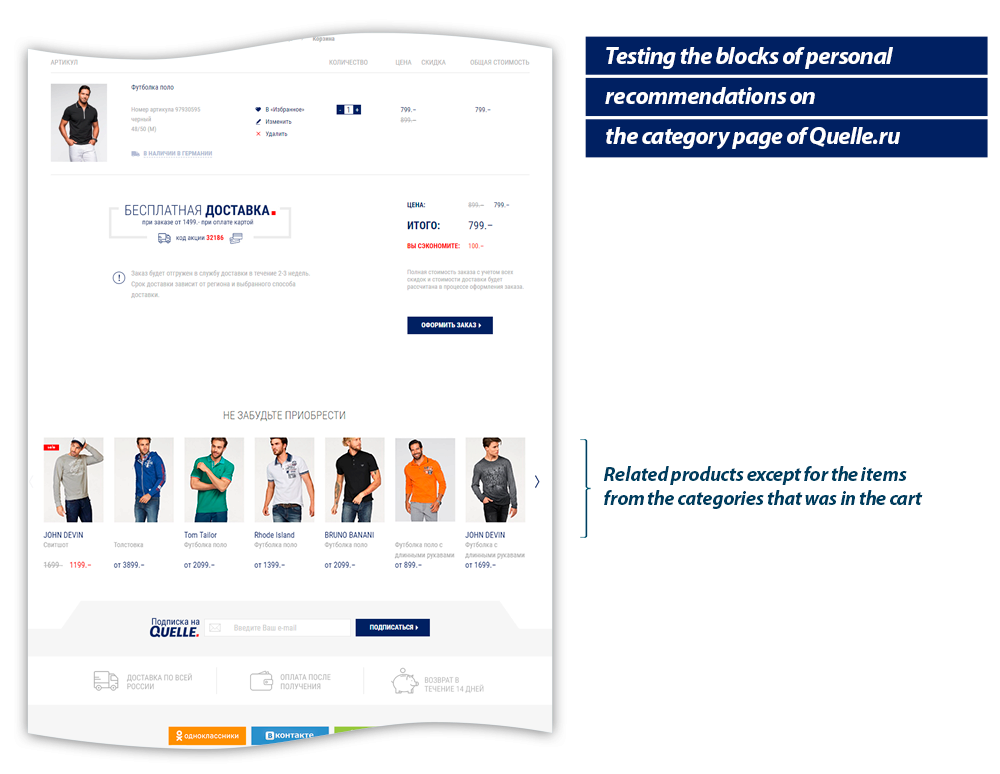
The third segment was shown related items after filtering out the top sellers, i.e. a selection of associated goods which excluded best sellers.

The fourth segment was shown recommendations of items from the “Accessories” category

Results
The test showed the following results:
| Conversion increase | |
| Related items (control group) | — |
| Related items from categories other than the browsed item category | +0.75% |
| Related items based on associative links | +0.56% |
| Recommendations of items from the “Accessories” category | +5.8% |
Conclusion
According to the test results, the use of the mechanics of “Related items from the ‘Accessories’ category” on the cart page of Quelle.ru online store increases the conversion rate of the visitors to the page with a recommendation block by 5.8% with a statistical significance of 99%.
Consequently, it is important to constantly test different mechanics and their variations in order to understand which recommendation algorithm works better in each particular case.
Comments from Quelle
 Competition in fashion is becoming more intense, which poses the following question to the retailers: Do you fight for a place in the sun by lowering your prices, thereby killing the margin, or do you focus on improving effectiveness, increasing the percentage little by little and maintaining good profitability? The latter is the path we have taken. Every 1% increase in conversion of the store’s key pages gives a tangible general increase in revenues. This is especially true when taking into account the current cost of incoming traffic. To us, the Retail Rocket team are not just contractors, but also great professionals in their field and people who share our views.
Competition in fashion is becoming more intense, which poses the following question to the retailers: Do you fight for a place in the sun by lowering your prices, thereby killing the margin, or do you focus on improving effectiveness, increasing the percentage little by little and maintaining good profitability? The latter is the path we have taken. Every 1% increase in conversion of the store’s key pages gives a tangible general increase in revenues. This is especially true when taking into account the current cost of incoming traffic. To us, the Retail Rocket team are not just contractors, but also great professionals in their field and people who share our views.
Andrey Osokin, Marketing Director of Quelle/Otto







